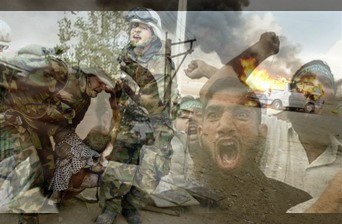Unleashing A Middle East Powder Keg
In From The Cold wonders How Israel Might Fight:
In the opening stages of the Israeli scenario, we believe the IDF would move quickly to seal off the West Bank and Gaza, without a major incursion into either region. With the limited strike options available to Hamas and the PA, Israel could wait to deal with those threats, while addressing more pressing concerns on its northern border, the Golan and in Iran.
As ground forces close off Gaza and the West Bank, the Israeli Air Force could launch its long-predicted strike against Iran, aimed at disabling that country's nuclear and long-range missile programs. Surprise is of the essence, and an early attack against Tehran would reduce that potential threat--before enemy air defenses go on heightened alert, and before the IDF become pre-occupied with operations over Lebanon and Syria.
Given the distance and routing considerations associated with the raid, the strike on Iran would (most likely) be a one-time shot. The Israelis understand that Tehran's retaliatory options are limited to attacks by proxies, and long-range strikes, using its relatively small arsenal of Shahab-3 missiles (the longer-range BM-25 is not believed operational at this time). Israel would employ the Arrow II ballistic missile defense system to counter MRBM attacks, and its own Jericho II missiles--capable of carrying nuclear warheads--for retaliatory strikes, as required.
With the Iranian threat reduced, the Israelis would quickly shift their focus to the Golan Heights and Lebanon. Syria's air force and air defenses could be neutralized rather quickly, giving the Israelis complete control of the skies, and support for a ground assault past the Golan. The IDF has no intention of occupying Damascus, just creating more strategic depth and eliminating forward bases for Syria's FROG-7 rocket force.
Additionally, IAF jets would also pound Syrian airfields that can accommodate cargo aircraft, to prevent aerial resupply from Iran, and trans-shipment to Hizballah. Syrian forces would provide determined resistance on the ground, but they are no match for the IDF. Damascus would also attempt to saturate Israel with missile and rocket attacks, but an IDF advance into Syrian territory would negate that threat, as would air dominance by the IAF. Syrian FROGS and SS-21 missiles are capable of carrying chemical warheads, but Damascus understands that a WMD strike on Israel would invite their own nuclear annihilation. Israel also has another advantage in the expected "missile war" with Syria--the availability of Patriot missile batteries, capable of handling the FROGs and SS-21s, leaving the Arrow II to battle Iran's MRBMs.
As the situation in Syria stabilizes, the IDF would shift its attention to Hizballah and Lebanon. As with Hamas in the south, Hizballah's attack options are limited. However, the success of their rocket attacks against Israel last summer makes it imperative for the IDF to deal with this threat, through a combination of airpower and a ground incursion. As with the Golan operation, the Israelis have no plan for a deep push into Lebanon; instead, they would focus on pushing Hizballah gunners out of range, and disrupting their supply lines into Syria.
After securing the northern front, the Israelis could then deal with the situations in Gaza and the West Bank. To avoid fighting on multiple fronts in the south and east, they might cut a deal with Fatah, allowing them to re-establish control in Gaza after Hamas is crushed. It's an agreement that Mahmoud Abbas would probably support, allowing the IDF to eliminate his enemies (at virtually no cost to Fatah) and pave his return to Gaza City.








No comments:
Post a Comment